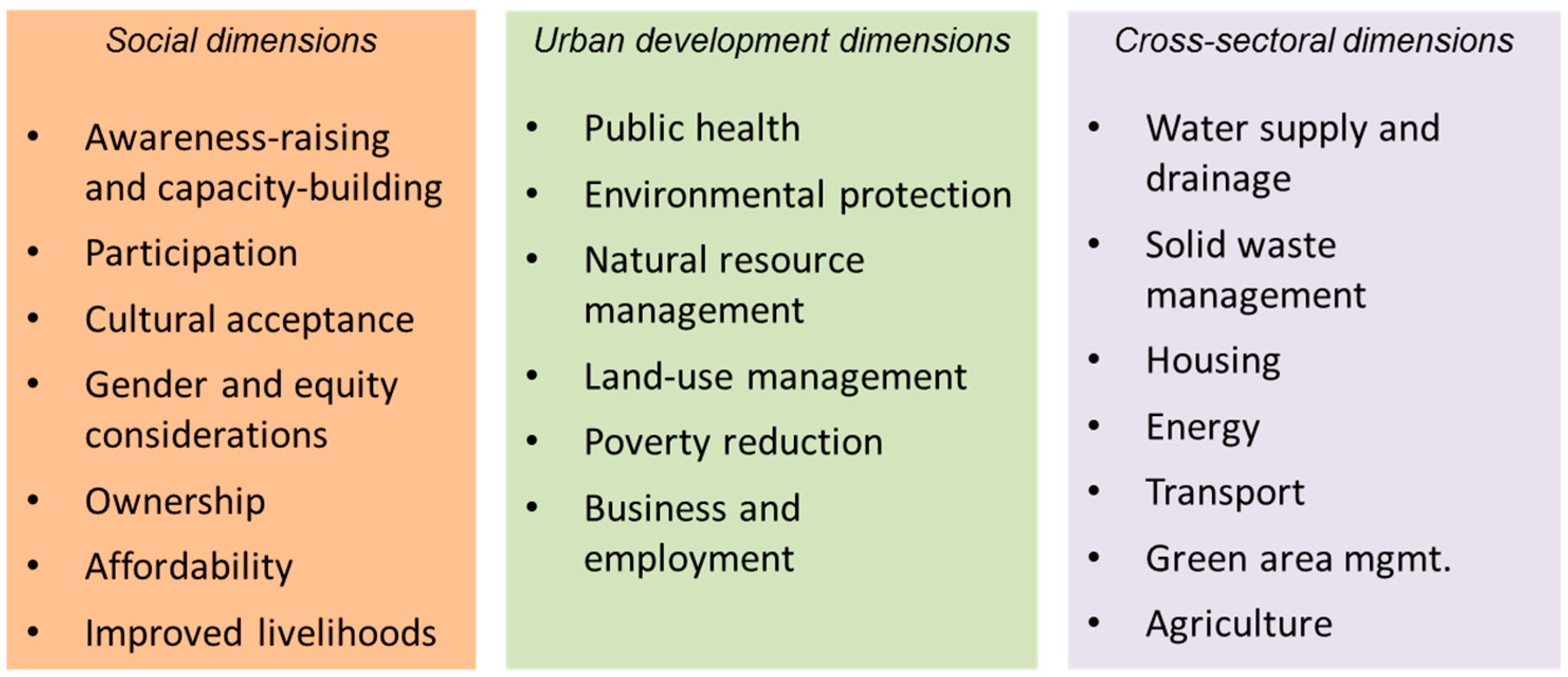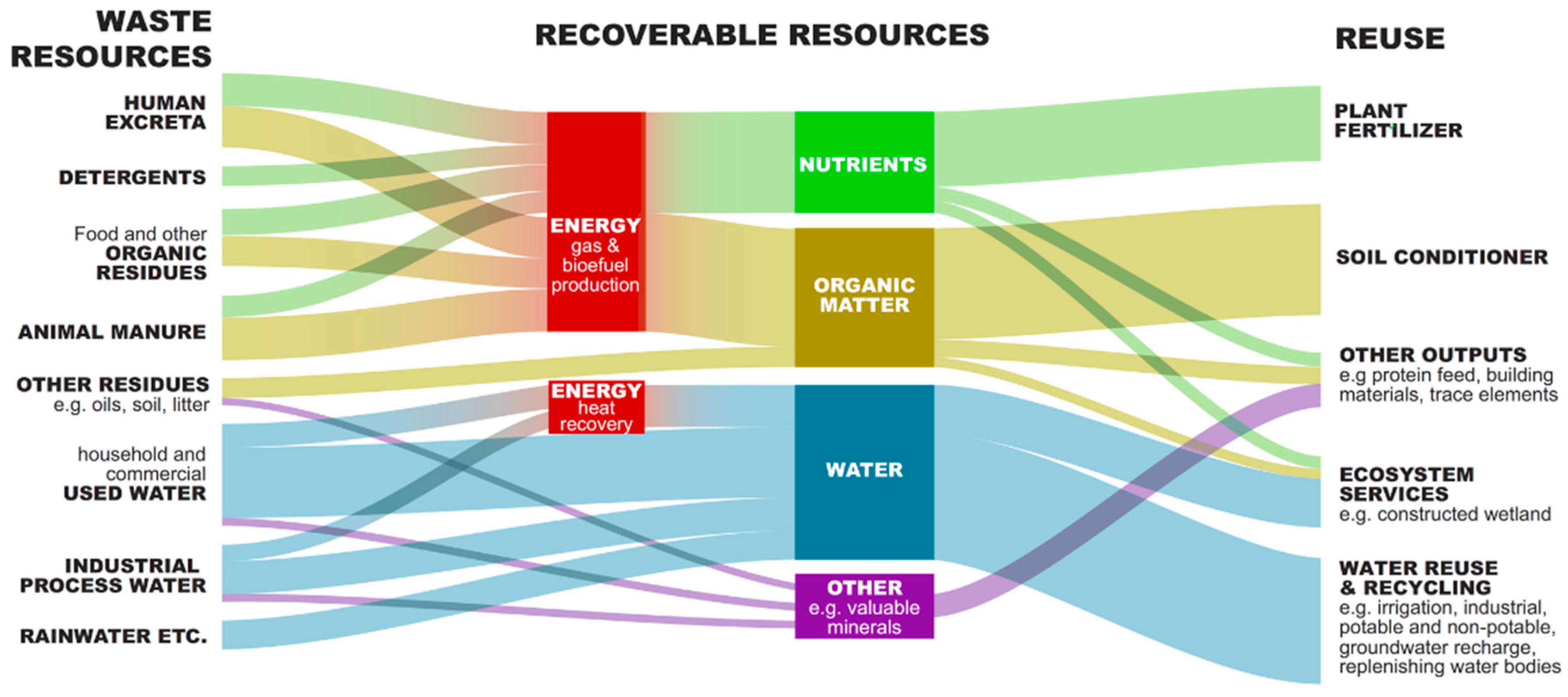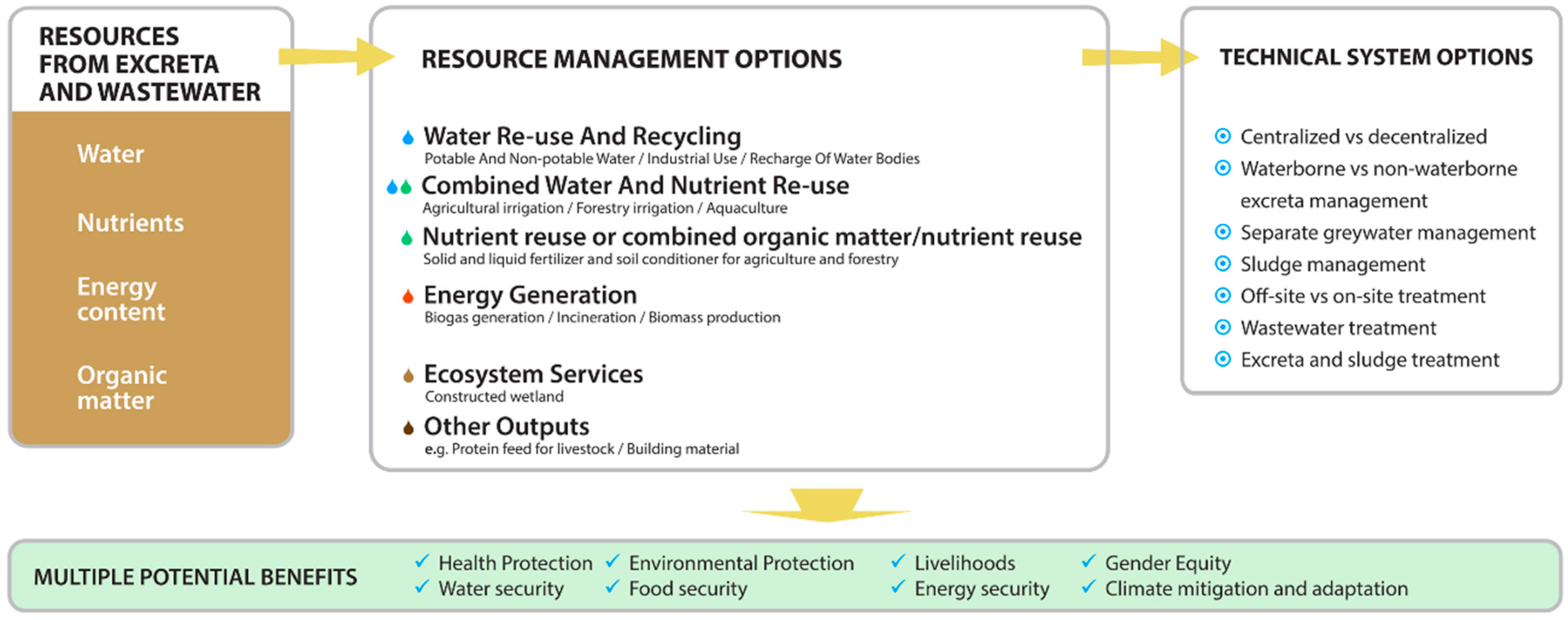Towards “Sustainable” Sanitation: Challenges and Opportunities in Urban Areas
Abstract
:1. Introduction
2. Beyond the Toilet: Complex Challenges Facing Urban Sanitation
2.1. Poor Access and Dysfunctional Systems
2.2. Inequitable Sanitation Systems
2.3. Health Risks Along the Entire Sanitation Chain
Emerging Health Risks
2.4. Low Prioritization of Sanitation: A Barrier to Achieving Sustainable Systems
2.4.1. Urban Populations Lack a Vital Link with Nature
2.4.2. Sanitation Requires Political Will and Dedicated Resources
2.4.3. Raising Global Awareness of Sanitation Challenges
2.5. Growing Pressure on Urban Environments
3. Sustainable Sanitation a Catalyst for Urban Development
3.1. Sustainable Sanitation Offers Opportunites for Resource Recovery
3.2. Sustainable Sanitation is a Good Economic, Social and Environmental Investment
3.3. Sustainable Sanitation Contributes to Multiple Sustainable Development Goals
- Goal 6, on clean water and sanitation, calls for access to adequate and equitable sanitation, and for improved wastewater management and, crucially, includes recycling and reuse, which sets sanitation in the context of a circular economy. This could relieve a large burden of infectious diseases within cities and downstream communities (Goal 3, good health and wellbeing). At the same time, equitable access can contribute to social development aims and reduce risks of gender-based violence (Goal 5, gender equity).
- Recovering and reusing the valuable resources present in excreta and wastewater streams also contributes to resource efficiency (Goal 12, sustainable consumption and production) and can help improve food security (Goal 2, zero hunger).
- Making tomorrow’s cities liveable (Goal 11, sustainable cities and communities) is not achievable without adequate sanitation and wastewater management. Working with the entire value chain linked to sustainable sanitation can provide new livelihood opportunities (Goal 1, no poverty; Goal 8, decent work and economic growth).
4. Conclusions
Acknowledgments
Author Contributions
Conflicts of Interest
References
- United Nations Children’s Fund (UNICEF); World Health Organization. Progress on Sanitation and Drinking Water: 2015 Update and MDG Assessment; UNICEF/WHO: New York, NY, USA, 2015. [Google Scholar]
- International Social Science Council (ISSC); The Institute of Development Studies (IDS); United Nations Educational, Scientific and Cultural Organization (UNESCO). World Social Science Report: Challenging Inequalities: Pathways to a Just World; UNESCO/ISSC: Paris, France, 2016. [Google Scholar]
- Angel, S.; Parent, J.; Civco, D.L.; Blei, A.M. Making Room for a Planet of Cities; Lincoln Institute of Land Policy: Cambridge, MA, USA.
- Seto, K.C.; Parnell, S.; Elmqvist, T. A Global Outlook on Urbanization. In Urbanization, Biodiversity and Ecosystem Services: Challenges and Opportunities; Elmqvist, T., Fragkias, M., Goodness, J., Güneralp, B., Marcotullio, P.J., McDonald, R.I., Parnell, S., Schewenius, M., Sendstad, M., Seto, K.C., et al., Eds.; Springer: New York, NY, USA, 2013. [Google Scholar]
- Rosemarin, A. Sustainable sanitation and water in small urban centres. Water Sci. Technol. 2005, 51, 109–118. [Google Scholar] [PubMed]
- Sustainable Sanitation Alliance. Towards More Sustainable Sanitation Solutions—SuSanA Vision Document. Available online: http://www.waterandmegacities.org/wastewater-treatment-in-hyderabad/ (accessed on 10 May 2016).
- Baum, R.; Luh, J.; Bartram, J. Sanitation: A Global Estimate of Sewerage Connections without Treatment and the Resulting Impact on MDG Progress. Environ. Sci. Technol. 2013, 47, 1994–2000. [Google Scholar] [CrossRef] [PubMed]
- Wankhade, K. Urban sanitation in India: Key shifts in the national policy frame. Environ. Urban. 2015, 27, 555–572. [Google Scholar] [CrossRef]
- Jenkins, M.W.; Cumming, O.; Cairncross, S. Pit latrine emptying behavior and demand for sanitation services in Dar Es Salaam, Tanzania. Int. J. Environ. Res. Public Health 2015, 12, 2588–2611. [Google Scholar] [CrossRef] [PubMed]
- Banerjee, G. Underground pollution travel from leach pits of on-site sanitation facilities: A case study. Clean Technol. Environ. Policy 2011, 13, 489–497. [Google Scholar] [CrossRef]
- Shivendra, B.T.; Ramaraju, H.K. Impact of Onsite Sanitation System on Groundwater in Different Geological Settings of Peri Urban Areas. Aquat. Procedia 2015, 4, 1162–1172. [Google Scholar] [CrossRef]
- Länsstyrelsen i Stockholms Län. Beräkning av Utsläpp och Effekter i Recipienten i Stockholms Län; Länsstyrelsen i Stockholms Län: Stockholm, Sweden, 2013. [Google Scholar]
- World Water Assessment Programme. The United Nations World Water Development Report 2015: Water for a Sustainable World; UNESCO: Paris, France, 2015. [Google Scholar]
- Joshi, D.; Fawcett, B.; Mannan, F. Health, hygiene and appropriate sanitation: Experiences and perceptions of the urban poor. Environ. Urban. 2011, 23, 91–111. [Google Scholar] [CrossRef]
- Rheingans, R.; Cumming, O.; Anderson, J.; Showalter, J. Estimating Inequities in Sanitation-Related Disease Burden and Estimating the Potential Impacts of Pro-Poor Targeting; SHARE (Sanitation and Hygiene Applied Research for Equity): London, UK, 2012. [Google Scholar]
- Wong, T.H.F.; Brown, R.R. The water sensitive city: principles for practice. Water Sci. Technol. 2009, 60, 673–682. [Google Scholar] [CrossRef] [PubMed]
- Moe, C.L.; Rheingans, R.D. Global challenges in water, sanitation and health. J. Water Health 2006, 4, 41–58. [Google Scholar] [PubMed]
- Kesztenbaum, L.; Rosenthal, J.-L. Sewers’ diffusion and the decline of mortality: The case of Paris, 1880–1914. J. Urban Econ. 2016, in press. [Google Scholar] [CrossRef]
- World Health Organization (WHO). Preventing Diarrhoea through Better Water, Sanitation and Hygiene: Exposures and Impacts in Low- and Middle-Income Countries; WHO: Geneva, Switzerland, 2014. [Google Scholar]
- Njoh, A.J. Urban Planning and Public Health in Africa: Historical, Theoretical and Practical Dimensions of a Continent’s Water and Sanitation Problematic; Ashgate Publishing Limited: Farnam, UK, 2012. [Google Scholar]
- O’Keefe, M.; Lüthi, C.; Tumwebaze, I.K.; Tobias, R. Opportunities and limits to market-driven sanitation services: Evidence from urban informal settlements in East Africa. Environ. Urban. 2015, 27, 421–440. [Google Scholar] [CrossRef]
- Massoud, M.A.; Tarhini, A.; Nasr, J.A. Decentralized approaches to wastewater treatment and management: Applicability in developing countries. J. Environ. Manag. 2009, 90, 652–659. [Google Scholar] [CrossRef] [PubMed]
- Wichelns, D.; Drechsel, P.; Qadir, M. Wastewater: Economic asset in an urbanizing world. In Wastewater: Economic Asset in an Urbanizing World; Drechsel, P., Qadir, M., Wichelns, D., Eds.; Springer: London, UK, 2015; pp. 3–14. [Google Scholar]
- Drechsel, P.; Graefe, S.; Sonou, M.; Cofie, O. Informal Irrigation in Urban West Africa: An Overview; IWMI Research Report 102; IWMI: Colombo, Sri Lanka, 2006. [Google Scholar]
- Dickin, S.K.; Schuster-Wallace, C.J.; Qadir, M.; Pizzacalla, K. A Review of Health Risks and Pathways for Exposure to Wastewater Use in Agriculture. Environ. Health Perspect. 2016, 124, 900–909. [Google Scholar] [CrossRef] [PubMed]
- World Health Organization (WHO). Antimicrobial Resistance: An Emerging Water, Sanitation and Hygiene Issue Briefing Note WHO/FWC/WSH/14.07; World Health Organizaitn: Geneva, Switzerland, 2014. [Google Scholar]
- Talukdar, P.K.; Rahman, M.; Nabi, A.; Islam, Z.; Hoque, M.M.; Endtz, H.P.; Islam, M.A. Antimicrobial Resistance, Virulence Factors and Genetic Diversity of Escherichia coli Isolates from Household Water Supply in Dhaka, Bangladesh. PLoS ONE 2013, 8, e61090. [Google Scholar] [CrossRef] [PubMed]
- Walsh, T.R.; Weeks, J.; Livermore, D.M.; Toleman, M.A. Dissemination of NDM-1 positive bacteria in the New Delhi environment and its implications for human health: An environmental point prevalence study. Lancet Infect. Dis. 2011, 11, 355–362. [Google Scholar] [CrossRef]
- Yale University. Environmental Performance Index; Yale University: New Haven, CT, USA, 2016. [Google Scholar]
- Zhang, Y.; Marrs, C.F.; Simon, C.; Xi, C. Wastewater treatment contributes to selective increase of antibiotic resistance among Acinetobacter spp. Sci. Total Environ. 2009, 407, 3702–3706. [Google Scholar] [CrossRef] [PubMed]
- World Health Organization (WHO). UN-Water Global Analysis and Assessment of Sanitation and Drinking-Water (GLAAS) 2014 Report: Investing in Water and Sanitation: Increasing Access, Reducing Inequalities; WHO: Geneva, Switzerland, 2014. [Google Scholar]
- Farrelly, M.A.; Brown, R.R. Making the implicit, explicit: Time for renegotiating the urban water supply hydrosocial contract? Urban Water J. 2014, 11, 392–404. [Google Scholar] [CrossRef]
- Shiffman, J. A social explanation for the rise and fall of global health issues. Bull. World Health Organ. 2009, 87, 608–613. [Google Scholar] [CrossRef] [PubMed]
- Carr, R. Excreta-related infections and the role of sanitation in the control of transmission. In Water Quality: Guidelines, Standards and Health. Assessment of Risk and Risk Management for Water-Relasted Infectious Diseases; Fewtrell, L., Bartram, J., Eds.; IWA Publishing: London, UK, 2001. [Google Scholar]
- Naughton, O.; Hynds, P.D. Public awareness, behaviours and attitudes towards domestic wastewater treatment systems in the Republic of Ireland. J. Hydrol. 2014, 518, 108–119. [Google Scholar] [CrossRef]
- Mines, R. Environmental Engineering: Principles and Practice; Wiley Blackwell: Oxford, UK, 2014. [Google Scholar]
- Felton, R. Flint’s contaminated water was among the most expensive in the country. The Guardian, 17 February 2016. [Google Scholar]
- European Comission. Eighth Report on the Implementation Status and the Programmes for Implementation of Council Directive 91/271/EEC Concerning Urban Waste Water Treatment; European Comission: Brussels, Belgium, 2016. [Google Scholar]
- Charlesworth, S.M.; Harker, E.; Rickard, S. A Review of Sustainable Drainage Systems (SuDS): A Soft Option for Hard Drainage Questions? Geography 2003, 88, 99–107. [Google Scholar]
- Poleto, C.; Tassi, R. Sustainable Urban Drainage Systems. In Drainage Systems; Javaid, M.S., Ed.; InTech: Rijeka, Croatia, 2012. [Google Scholar]
- Bader, B. Wastewater Treatment in Hyderabad. Available online: http://www.waterandmegacities.org/wastewater-treatment-in-hyderabad/ (accessed on 15 April 2016).
- Wang, H.; Wang, T.; Zhang, B.; Li, F.; Toure, B.; Omosa, I.B.; Chiramba, T.; Abdel-Monem, M.; Pradhan, M. Water and Wastewater Treatment in Africa—Current Practices and Challenges. CLEAN Soil Air Water 2014, 42, 1029–1035. [Google Scholar] [CrossRef]
- Cooper, P. Historical aspects of wastewater treatment. In Decentralised Sanitation and Reuse: Concepts, Systems and Implementation; Lens, P., Lens, P.N.L., Zeeman, G., Lettinga, G., Eds.; IWA Publishing: London, UK, 2001. [Google Scholar]
- The Organisation for Economic Co-operation and Development (OECD). Better Policies for Development 2014: Policy Coherence and Illicit Financial Flows; OECD: Paris, France, 2014. [Google Scholar]
- United Nations Department of Economic and Social Affairs Population Division. World Urbanization Prospects: The 2014 Revision, Highlights (ST/ESA/SER.A/352); UN DESA: New York, NY, USA, 2014. [Google Scholar]
- UN-Habitat. World Cities Report 2016: Urbanization and Development: Emerging Futures; UN-HABITAT: Nairobi, Kenya, 2016. [Google Scholar]
- Mulyana, W.; Setiono, I.; Selzer, A.K.; Zhang, S.; Dodman, D.; Schensul, D. Urbanisation, Demographics and Adaptation to Climate Change in Semarang, Indonesia; IIED/UNFPA: London, UK, 2013. [Google Scholar]
- Braga, B.; Kelman, J. Facing the challenge of extreme climate: The case of Metropolitan Sao Paulo. Water Policy 2016. [Google Scholar] [CrossRef]
- Afifi, S.; Alnahhal, S.; Abdelall, S. Developing an integrated sustainable sanitation system for urban areas: Gaza strip case study. Procedia CIRP 2015, 26, 767–774. [Google Scholar] [CrossRef]
- Anand, C.K.; Apul, D.S. Composting toilets as a sustainable alternative to urban sanitation—A review. Waste Manag. 2014, 34, 329–343. [Google Scholar] [CrossRef] [PubMed]
- UN-Habitat. Inclusive and Sustainable Urban Planning: A Guide for Municipalities, Volume 1; UN-HABITAT: Nairobi, Kenya, 2007. [Google Scholar]
- European Commission. Consultative Guidelines for Sustainable Urban Development Co-operation. Towards Sustainable Urban Development: A Strategic Approach; European Commission: Brussels, Belgium, 2002. [Google Scholar]
- Andersson, K.; Rosemarin, A.; Lamizana, B.; Kvarnström, E.; McConville, J.; Seidu, R.; Dickin, S.; Trimmer, C. Sanitation, Wastewater Management and Sustainability: From Waste Disposal to Resource Recovery; UNEP/GPA/SEI: Stockholm, Sweden, 2016. [Google Scholar]
- Dagerskog, L.; Morgan, P.; Still, D.; Ochiro, B.; Ekane, N.; Henry, L.; Harawa, K. Food security in Sub-Saharan Africa—What could be the contribution of productive sanitation? In Sanitation and Hygiene in Africa—Where Do We Stand? IWA publishing: London, UK, 2014. [Google Scholar]
- Seidu, R. Disentangling the Risk Factors and Health Risks Associated with Faecal Sludge and Wastewater Reuse in Ghana; Norwegian University of Life Sciences: Ås, Norway, 2010. [Google Scholar]
- Persson, T.; Svensson, M.; Finnson, A. REVAQ Certified Wastewater Treatment Plants in Sweden for Improved Quality of Recycled Digestate Nutrients; IEA Bioenergy Task 37: Stockholm, Sweden, 2015. [Google Scholar]
- Weiland, P. Biogas production: Current state and perspectives. Appl. Microbiol. Biotechnol. 2010, 85, 849–860. [Google Scholar] [CrossRef] [PubMed]
- Stenström, T.A.; Seidu, R.; Ekane, N.; Zurbrügg, C. Microbial Exposure and Health Assessments in Sanitation Technologies and Systems; EcoSanRes: Stockholm, Sweden, 2011. [Google Scholar]
- World Bank Water and Sanitation Program. Economic Impacts of Inadequate Sanitation in India; World Bank: New Delhi, India, 2011. [Google Scholar]
- Institute for Sustainable Futures (ISF), University of Technology Sydney. Financing Sanitation for Cities and Towns: Learning Paper; Institute for Sustainable Futures: Sydney, Australia, 2014. [Google Scholar]
- Heinz, I.; Salgot, M.; Mateo-Sagasta Dávila, J. Evaluating the costs and benefits of water reuse and exchange projects involving cities and farmers. Water Int. 2011, 36, 455–466. [Google Scholar] [CrossRef]
- Verlicchi, P.; Al Aukidy, M.; Galletti, A.; Zambello, E.; Zanni, G.; Masotti, L. A project of reuse of reclaimed wastewater in the Po Valley, Italy: Polishing sequence and cost benefit analysis. J. Hydrol. 2012, 432–433, 127–136. [Google Scholar] [CrossRef]
- Blackett, I.; Hawkins, P.; Heymans, C. The Missing Link in Sanitation Service Delivery. A Review of Fecal Sludge Management in 12 Cities; World Bank Group: Washington, DC, USA, 2014. [Google Scholar]
- Ddiba, D.; Andersson, K.; Rosemarin, A. Resource Value Mapping (REVAMP): A Tool for Evaluating the Resource Recovery Potential of Urban Waste Streams; SEI: Stockholm, Sweden, 2016. [Google Scholar]
- Ddiba, D. Estimating the Potential for Resource Recovery from Productive Sanitation in Urban Areas; KTH Royal Institute of Technology: Stockholm, Sweden, 2016. [Google Scholar]



© 2016 by the authors; licensee MDPI, Basel, Switzerland. This article is an open access article distributed under the terms and conditions of the Creative Commons Attribution (CC-BY) license (http://creativecommons.org/licenses/by/4.0/).
Share and Cite
Andersson, K.; Dickin, S.; Rosemarin, A. Towards “Sustainable” Sanitation: Challenges and Opportunities in Urban Areas. Sustainability 2016, 8, 1289. https://doi.org/10.3390/su8121289
Andersson K, Dickin S, Rosemarin A. Towards “Sustainable” Sanitation: Challenges and Opportunities in Urban Areas. Sustainability. 2016; 8(12):1289. https://doi.org/10.3390/su8121289
Chicago/Turabian StyleAndersson, Kim, Sarah Dickin, and Arno Rosemarin. 2016. "Towards “Sustainable” Sanitation: Challenges and Opportunities in Urban Areas" Sustainability 8, no. 12: 1289. https://doi.org/10.3390/su8121289
APA StyleAndersson, K., Dickin, S., & Rosemarin, A. (2016). Towards “Sustainable” Sanitation: Challenges and Opportunities in Urban Areas. Sustainability, 8(12), 1289. https://doi.org/10.3390/su8121289





